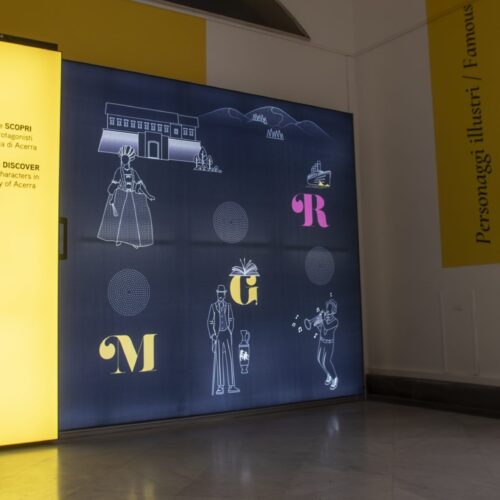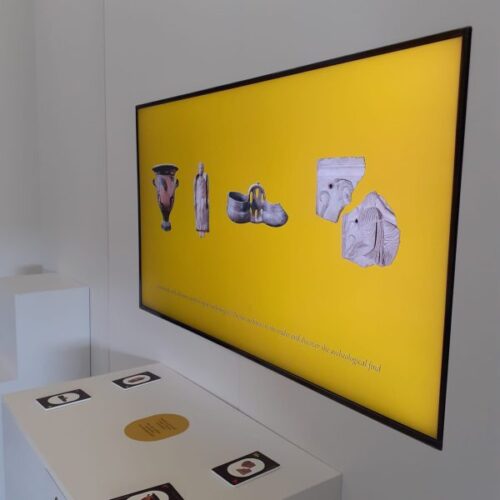Castle of the Counts of Acerra
OUR SERVICES


The route
The ground floor and the second floor
Once inside the Castle, the ground floor houses a number of exhibits dedicated to an initial introduction and orientation among the places and themes addressed in the tour route. The two areas designed to welcome visitors respectively host a touch lectern with an in-depth study dedicated to Pulcinella with cards and images dedicated to different themes related to the famous mask, and a touch monitor designed to accompany during the exit phase from the museum itinerary, accompanying visitors in the post-experience. Another touch delves into the architectural evolution of the Castle.
The courtyard of the Castle hosts a videomapping, intended to welcome visitors during events and evening openings. The station appears to be properly completed, installed and functioning. The first floor has several orientation panels, to accompany the visitor during the visit to the walkways.
Virtual Museum of Archaeology
The Virtual Museum of Archaeology houses several multimedia exhibits, organized in a path that can support the visitor to contextualize and place on an ideal timeline the historical events and places of Acerra.
Corridor: the corridor is set up with a timeline consisting of 3 panels that can give an initial historical and temporal context to visitors, so as to accompany them as they enter the exhibit.
Room 4: a touch lectern allows in-depth exploration of several cards and sections dedicated to the evolution of the territory of Acerra and surrounding areas.
Room 6: the room hosts the Talking Objects exhibit: through videos activated on a monitor thanks to the visitor’s interaction, objects tell their story, their use or finding.
Room 7: A Sliding monitor introduces visitors to four main protagonists of Acerra’s history. The adjacent wall houses a touch monitor through which visitors can discover the history of encastellation in Campania and throughout southern Italy.
Room 10-12 : dedicated to “Gneo Stennio Egnazio” and “Maria Giuseppa De Cardenas,” the rooms host two rear-projections dedicated to two symbolic characters of two great moments of the city of Acerra.
Room 11: hosts a station consisting of a touch totem dedicated to Gaetano Caporale, a citizen and famous historian originally from the city of Acerra, who wrote its memoirs.
Room 13: hrough short videos and cards via a touch table, it is possible to delve into the subject of Folklore.
Room 14: the Ortorama exhibit allows visitors to explore different topics interactively, choosing what to explore, discovering the history connected to the exhibits or artifacts indicated.
Room 15: a touch monitor dedicated to the Ancient City of Suessola, now home to the Park of the Ancient City of Suessola.
Room 16: the Talking Wall exhibit, allows visitors to activate videos dedicated to the twentieth century, the short century, from the perspective of the city of Acerra thanks to special sensors.
Room 9: The Virtual Museum of Archaeology tour ends with an immersive room dedicated to the history of the Roman theater identified under the castle walls.
Museum of Musical Traditions
The Museum of Musical Traditions is dedicated to the evolution of Acerran musical production, with a specific level of attention to the centuries-old band tradition, of which a great deal of evidence remains in the form of paper documents and period musical instruments.
Room 22: the first room dedicated to the music-themed itinerary is set up with a station consisting of a touch monitor and headphones: the station is a first approach to the sounds and atmosphere typical of the Acerra band, allowing visitors to listen to some symphonies dedicated to the city. A monitor allows visitors to listen to and enjoy the most famous performances of the city band, getting in touch with festivals, anniversaries and special celebrations related to them.
Room 19: the room houses a touch lectern that enables visitors to learn more about the history of the famous Acerra Band, from its 1840 foundation until the temporary suspension of its activities during the world wars and its refounding in 1989, followed by the founding of the city music school.
Room 23: the journey continues to a station consisting of a touch table housing a selection of period scores.
Room 24: a wall-mounted interactive video projection dedicated to Raffaele Martire (pseudonym: Ralph Marterie).
Room 20: a solution dedicated to listening to No. 12 audio tracks connected to ancient and modern musical instruments displayed in the room. Using special sensors and headphones, visitors can listen to two audio tracks dedicated to each musical instrument on display in order to understand its acoustic and expressive potential.
Room 21: a touch totem dedicated to the discovery of small biographical cards and photo galleries dedicated to the musicians who have made Acerra and its band famous, in Italy or abroad, playing in famous and renowned orchestras.
The visit route has been implemented with several wall graphics, created with the purpose of enhancing the visit route.
The visit app features a division into two distinct routes: the first one is strictly dedicated to visiting the Castle halls and features 15 Points of Interest – POIs, the second one is intended to support the visitor in the whole area though 10 POIs. Each Point of Interest – both of the route inside the Castle and in the one through the city streets – features an in-depth textual sheet, a pictures gallery and an explanatory audio, which performs the function of a real audio guide and accompanies the public to discover the different museum or territorial areas.
The renewal of the visiting experience at the Conti Castle is also presented to the public through the creation of a dedicated Website, developed according to the museum’s graphic design. The site contains practical information for the visit (schedules, tourist information, etc.) and a first approach to the content covered.
